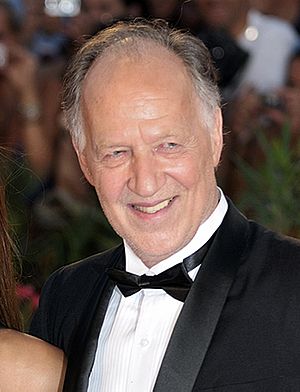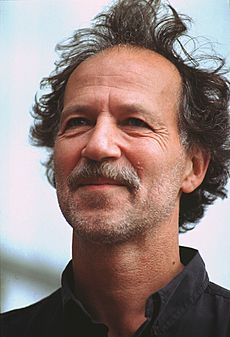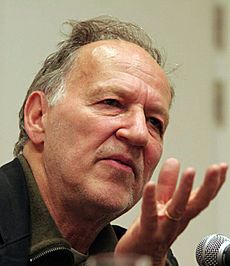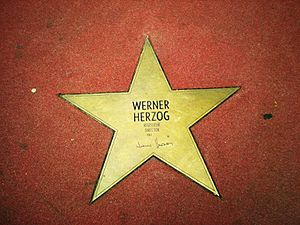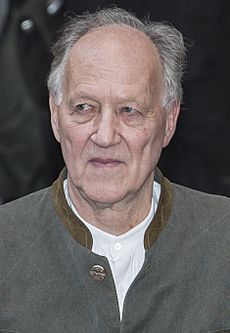Werner Herzog facts for kids
Werner Herzog (born 5 September 1942) is a famous German filmmaker, actor, and writer. He is known for making unique movies and documentaries. Many people see him as a leader of the "New German Cinema" movement. This was a time when German filmmakers created new and exciting kinds of movies.
Herzog's films often show characters who have big, almost impossible dreams. They might be people with special talents or individuals facing challenges from nature. He likes to film without using detailed storyboards. Instead, he often improvises and puts his actors and crew in real-life situations.
Since 1961, Herzog has made over sixty films and documentaries. Some of his well-known works include Aguirre, the Wrath of God (1972), Fitzcarraldo (1982), Grizzly Man (2005), and Cave of Forgotten Dreams (2010). He has also written many books and directed operas.
Famous film critic Roger Ebert once said that Herzog's films are always interesting and never made just for money. In 2009, Time magazine named him one of the world's 100 most influential people.
Contents
About Werner Herzog's Life
Growing Up and Early Years
Werner Herzog was born Werner Stipetić in Munich, Germany, on 5 September 1942. His mother was Austrian, and his father was German. When he was very young, his mother moved them to a small village called Sachrang in the mountains. This was during World War II, and their home in Munich was near a bombed area.
He grew up with his older brother Till and younger half-brother Lucki. They lived without modern things like running water or a telephone. Herzog remembers not having toys or tools. He didn't even know what movies were until a traveling projectionist showed films at his school.
When Herzog was 12, his family moved back to Munich. He later changed his last name to Herzog, which means "duke" in German. He thought it sounded better for a filmmaker. He made his first phone call at 17 and started his first film, Herakles, at 19.
Herzog had a strong interest in music when he was 18. He also became very interested in filmmaking. He learned the basics from an encyclopedia. He even "borrowed" a camera from the Munich Film School because he felt it was necessary for his work.
To pay for his early films, Herzog worked night shifts as a welder in a steel factory. After high school, he lived in Manchester, England, for a few months to learn English. He also briefly studied history and literature at the University of Munich.
Filmmaking Journey: 1962–2005
Werner Herzog was a key figure in the New German Cinema movement. This movement included directors like Rainer Werner Fassbinder and Wim Wenders. These filmmakers often made movies with small budgets. Herzog liked to use both professional actors and local people in his films. His movies often have a mysterious feel and are set in unusual places.
In 1971, Herzog was looking for filming locations in Peru for his movie Aguirre, the Wrath of God. He almost took a flight that later crashed due to lightning. One person, Juliane Koepcke, survived the fall. Herzog was deeply affected by this event. Years later, he made a documentary called Wings of Hope (1998) about her story.
Herzog has won many awards for his films. His first big award was the Silver Bear for Signs of Life in 1968. He won Best Director at the 1982 Cannes Film Festival for Fitzcarraldo. His film The Enigma of Kaspar Hauser won a special jury prize at Cannes in 1975.
In 1978, Herzog made a famous promise. He said he would eat his shoe if his friend, filmmaker Errol Morris, finished his film Gates of Heaven. When Morris finished the film, Herzog kept his promise. He cooked and publicly ate his shoe. This event was even made into a short documentary called Werner Herzog Eats His Shoe (1980). Herzog did this to encourage Morris and show that you should always finish what you start.
In the winter of 1974, Herzog walked from Munich to Paris. He did this because his friend and mentor, Lotte H. Eisner, was very sick. He believed that if he walked, she would not die. He kept a diary of his journey, which was later published as Of Walking in Ice.
In the late 1990s, Werner Herzog moved to Los Angeles. He found the city exciting and full of dreams. He liked that it was a place where things "get done."
Recent Directing Work: 2006 Onwards
Herzog continued to receive honors for his work. In 2006, he was recognized at the San Francisco International Film Festival. That same year, he was giving an interview when he was shot in the stomach with an air rifle. He continued the interview without stopping, saying it wasn't serious. He later joked that he seems to attract "clinically insane" people.
His documentary Encounters at the End of the World, filmed in Antarctica, won an award in 2008. It was also nominated for an Academy Award for Best Documentary Feature, which was Herzog's first Oscar nomination. In 2009, he had two films in competition at the Venice Film Festival. This was a rare achievement for a filmmaker.
In 2010, Herzog made Cave of Forgotten Dreams. This documentary takes viewers inside the Chauvet Cave in France, showing ancient cave paintings. He filmed it in 3-D, even though he usually doesn't like 3-D movies. He also co-directed Happy People: A Year in the Taiga, which shows the lives of fur trappers in Siberia.
Herzog often narrates his own documentary films. In 2014, he completed Queen of the Desert. This movie starred Nicole Kidman and Robert Pattinson. In 2015, he filmed Salt and Fire in Bolivia.
Acting and Other Projects
Herzog is not happy with how traditional film schools teach. So, in 2009, he started his own "Rogue Film School." He prefers students who have had interesting life experiences. He believes that real-life adventures are more important for a filmmaker than just studying in a classroom.
In 2010, Herzog started doing voice work for animated TV shows. He appeared in The Boondocks and The Simpsons. He also lent his voice to American Dad! and Rick and Morty.
In 2012, Herzog acted in the action film Jack Reacher with Tom Cruise. He played the villain, Zec Chelovek. In 2013, he made a short documentary called From One Second to the Next. This film showed the dangers of texting while driving. It was shared widely in high schools to promote safety.
In 2019, Herzog joined the cast of the Star Wars TV series The Mandalorian. He played a character called "The Client." He took the role because he liked the script, even though he had never seen any Star Wars movies before.
In June 2022, Herzog published his first novel, The Twilight World. The book tells the story of Hiroo Onoda, a Japanese soldier who hid in a jungle for decades after World War II ended. Herzog had met Onoda years before and was inspired by his story.
Herzog's Ideas About Film
His Unique Style
Herzog's films are often praised by critics and popular with audiences who enjoy unique movies. They sometimes cause discussion because of their themes and how they were made. For example, during the making of Fitzcarraldo, Herzog faced many challenges. This reflected the main character's own difficult journey in the film. A documentary called Burden of Dreams was made about the tough conditions during the filming of Fitzcarraldo.
Herzog believes that our world needs "new images." He thinks that many of the images we see are old and boring. He sees it as his job to help us find new and exciting ways to see the world through film. He is proud that he never uses detailed storyboards. He often makes up parts of the script as he goes along.
In 1999, Herzog wrote a statement called the "Minnesota Declaration." In it, he explained his idea of "ecstatic truth." He said that regular facts only show a surface truth. But there is a deeper, "poetic, ecstatic truth" that can be found through imagination and storytelling. He believes that sometimes, facts can be so strange that they seem unbelievable.
Teaching Filmmaking
Herzog has taught several filmmaking workshops. From 2009 to 2016, he ran his "Rogue Film School." Young directors spent time with him in interesting places. The school was a bit mysterious, but it focused on practical lessons. These included how music works in film and how to get permission to film.
In 2018, he led a workshop in the Amazon rainforest in Peru. New filmmakers made short films under his guidance. Herzog was very impressed with their work. He also teaches a filmmaking course online through a website called MasterClass.
Werner Herzog's Personal Life
Herzog has been married three times and has three children. He married Martje Grohmann in 1967, and they had a son. They divorced in 1985. He then had a daughter with actress Eva Mattes. In 1987, he married Christine Maria Ebenberger, and they had a son. They divorced in 1997. In 1999, he married Russian-American photographer Elena Pisetski. They live in Los Angeles.
Herzog loves to read. He has recommended books like The Peregrine by J. A. Baker and Georgics by Virgil for his film students. He is described as an atheist. Besides German, he speaks English, French, Greek, Italian, and Spanish. He can also read Latin and Ancient Greek.
Werner Herzog's Films
Since 1962, Werner Herzog has directed many films. These include 20 fiction feature films, 7 fiction short films, and 34 documentary feature films. He has also written or co-written all of his films. He has appeared as an actor in 26 film or television productions.
Stage Works
Operas Directed
- Doktor Faust (1986)
- Lohengrin (1987)
- Giovanna d'Arco (1989)
- The Magic Flute (1991)
- La donna del lago (1992)
- Der fliegende Holländer (1993)
- Norma (1994)
- Il Guarany (1994, 1996)
- Tannhäuser (1997, 1998, 1999, 2000, 2001)
- Chūshingura (1997)
- Fidelio (1999, 2003)
- Giovanna d'Arco (2001)
- Parsifal (2008)
- I due Foscari (2013)
Theatre Plays Directed
- Varété (1992)
- Floresta Amazonica (A Midsummer Night's Dream) (1992)
- Specialitaeten (1993)
Concerts Directed
- The Killers: Unstaged (2012)
See also
 In Spanish: Werner Herzog para niños
In Spanish: Werner Herzog para niños


